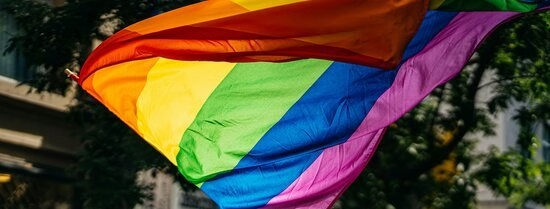The TV series "Glee" helped PhD candidate Bartosz Zerebecki (ESHCC) to come out. This led him to question: can films and TV series also help others to develop their own identity and increase positive attitudes? Zerebecki is currently investigating this his PhD research. 'I’m interested to find out when audiences feel connected to LGBTQIA+ characters and how this connection can improve empathy and reduce prejudice', he explains.
From personal experience to academic research
Zerebecki's passion for this topic is deeply personal. Growing up in Poland and identifying as a gay man, he says that TV series played a significant role in helping him navigate his own identity. He recalls watching Glee during flights to the U.S., where he studied. He remembers feeling a sense of freedom as he left behind the restrictive norms of Polish society. 'Glee was my guilty pleasure, but also something much more powerful—it helped me imagine a version of myself I could grow into', he states.
Motivated by this transformative experience, he began to wonder if media can do for others what it did for him. Could it help shift societal views, especially in countries where acceptance is still lagging? These questions shaped his PhD research.

'If TV helped me come out, maybe it can help others too'
Bartosz Zerebecki
PhD candidate
Originally, Zerebecki intended to focus his study on Polish high schoolers, but political realities in the country complicated this. At the time of his data collection, Poland’s right-wing government was threatening to limit external research access to schools, particularly if it addressed topics like LGBTQIA+ issues. As a result, he broadened his scope. His research now includes international students in the Netherlands, a group from the United States, and Polish adults aged 18–40. 'That shift actually strengthened my research because it made it more globally relevant', he says.
A psychological perspective on representation
A lot of research in this area focuses on media or cultural studies, which tend to analyse how representations reproduce certain dominant ideologies such as racism or capitalism. Zerebecki's approach is more rooted in communication science and media psychology. He is interested the inner thoughts of characters, the conversations they have, how they navigate certain situations, and how audiences see themselves in those narratives. 'Polish youth I interviewed found it hard to say if they were similar to a character', Zerebecki explains. 'But they could point to specific scenes that resonated with them.'

This led him to develop the Character Recognizability Scale. This research tool evaluates whether viewers recognise themselves in a character's strengths, weaknesses, thoughts, and emotional responses. 'It’s not just about being gay or straight', he says. 'It’s about whether people see themselves in the character's inner life.'
What makes representation 'successful'?
Zerebecki has come up with six strategies that he says contribute to what he calls "successful minority representation":
- Representation of minority experiences
These include culturally specific events (like Eric attending a Black church in the tv series Sex Education) or common LGBTQIA+ moments such as coming out. ‘But there’s a danger here’, he warns. ‘Showing too much trauma, like racism or homophobia, can re-traumatize viewers.’ Instead, he points out shows like Heartstopper, which refer to past bullying but don’t depict it graphically—acknowledging pain without reproducing it. - Recognizable (universal) experiences
‘Viewers from non-minority backgrounds often relate better to characters when they face universal challenges—falling in love, struggling at school, or dealing with family’, Zerebecki states. He names Pose as a good example, where scenes of chosen family dinners allow broader audiences to see transgender and Black characters in relatable, everyday situations. ‘It helps viewers realise that people of the LGBTQIA+ community aren’t that different.’ - Attractive personality traits
Zerebecki emphasizes the importance of showing likable, successful characters. ‘We had too many queer villains in the past’, he says. ‘Now, we need characters who are joyful, inspiring, and admirable.’ - Psychological depth
Characters should have struggles and motivations, not just identities. ‘When you understand why a character behaves a certain way, you see them as human’, he says. He points out Charlie from Heartstopper, who struggles to connect with Nick because of his past trauma - adding depth and relatability. - Counter-stereotypical representation
He says it’s important to move beyond clichés. ‘Yes, some gay men are feminine—but not all are. The danger lies in having only one type of representation.’ For example, Sex Education offers a range: Eric is flamboyant, whereas Adam is more reserved. ‘That variety reflects real diversity’, he says. - Friendly interactions
‘Seeing positive relationships between minority and majority characters can influence viewers’ real-life behavior’, Zerebecki states. ‘When straight people are shown supporting LGBTQIA+ friends, that models good behavior’, he says, pointing to Heartstopper scenes of supportive families and friends.
These six representation strategies result in audience engagement and prejudice reduction. People who recalled seeing those strategies in films and tv series, reported higher empathy towards queer people three months later. 'It was a natural effect, without external stimulus’, Zerebecki says.
Media as a tool for change
Zerebecki says these representation strategies are not just for queer viewers. ‘We found that straight and cisgender people can also connect with LGBTQIA+ characters, through deep-level similarities’, he explains. ‘That connection increases empathy.’
With conservative ideologies gaining ground globally, he believes this research is more important than ever. ‘Of course we need legislation, activism, education—but entertainment can also help’, he says. While online discourse often criticizes diverse casting as “forced”, Zerebecki insists that many viewers appreciate these stories. ‘Representation matters—for everyone’, he says. ‘Not every show needs to be centered around LGBTQIA+ issues, but including these characters in meaningful ways can make a real difference.’
- More information
More science stories? Check out our online magazine Erasmus Extra.
Press
Do you have any questions about Zerebecki or his research? Please get in touch with press officer of ESHCC Julia Wetsteijn through e-mail or phone: 010 – 4082316- Related content

